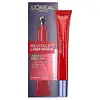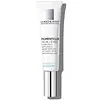What's inside
What's inside
 Key Ingredients
Key Ingredients

 Benefits
Benefits

 Concerns
Concerns

 Ingredients Side-by-side
Ingredients Side-by-side

Water
Skin ConditioningDipropylene Glycol
HumectantDimethicone
EmollientGlycerin
HumectantHydroxypropyl Tetrahydropyrantriol
Skin ConditioningPropylene Glycol
HumectantC12-15 Alkyl Benzoate
AntimicrobialAlcohol Denat.
AntimicrobialDimethicone/Vinyl Dimethicone Crosspolymer
Skin Conditioning2-Oleamido-1,3-Octadecanediol
Skin ConditioningCapryloyl Salicylic Acid
ExfoliatingDisodium EDTA
Hydrolyzed Hyaluronic Acid
HumectantPotassium Hydroxide
BufferingSodium Chloride
MaskingSodium Citrate
BufferingAscorbyl Glucoside
AntioxidantTocopherol
AntioxidantCetyl Alcohol
EmollientOctyldodecanol
EmollientSilica
AbrasiveCarbomer
Emulsion StabilisingCI 77891
Cosmetic ColorantGlyceryl Stearate
EmollientHydroxyethylcellulose
Emulsion StabilisingMica
Cosmetic ColorantMyristic Acid
CleansingPalmitic Acid
EmollientPEG-100 Stearate
Potassium Cetyl Phosphate
EmulsifyingStearic Acid
CleansingTin Oxide
AbrasiveXanthan Gum
EmulsifyingBenzyl Alcohol
PerfumingCitronellol
PerfumingLimonene
PerfumingLinalool
PerfumingCI 15985
Cosmetic ColorantCI 19140
Cosmetic ColorantPhenoxyethanol
PreservativeParfum
MaskingWater, Dipropylene Glycol, Dimethicone, Glycerin, Hydroxypropyl Tetrahydropyrantriol, Propylene Glycol, C12-15 Alkyl Benzoate, Alcohol Denat., Dimethicone/Vinyl Dimethicone Crosspolymer, 2-Oleamido-1,3-Octadecanediol, Capryloyl Salicylic Acid, Disodium EDTA, Hydrolyzed Hyaluronic Acid, Potassium Hydroxide, Sodium Chloride, Sodium Citrate, Ascorbyl Glucoside, Tocopherol, Cetyl Alcohol, Octyldodecanol, Silica, Carbomer, CI 77891, Glyceryl Stearate, Hydroxyethylcellulose, Mica, Myristic Acid, Palmitic Acid, PEG-100 Stearate, Potassium Cetyl Phosphate, Stearic Acid, Tin Oxide, Xanthan Gum, Benzyl Alcohol, Citronellol, Limonene, Linalool, CI 15985, CI 19140, Phenoxyethanol, Parfum
Water
Skin ConditioningGlycerin
HumectantButylene Glycol
HumectantDimethicone
EmollientNiacinamide
SmoothingIsopropyl Palmitate
EmollientCetearyl Alcohol
EmollientAmmonium Polyacryloyldimethyl Taurate
Emulsion StabilisingButyrospermum Parkii Butter
Skin ConditioningPEG-100 Stearate
PEG/PPG/Polybutylene Glycol-8/5/3 Glycerin
HumectantStearic Acid
CleansingGlyceryl Stearate
EmollientDimethicone/Vinyl Dimethicone Crosspolymer
Skin ConditioningDimethiconol
EmollientCaffeine
Skin ConditioningSodium Hydroxide
BufferingSilica
AbrasiveGinkgo Biloba Leaf Extract
Skin ConditioningPalmitic Acid
EmollientAlumina
AbrasivePhenylethyl Resorcinol
AntioxidantAscorbyl Glucoside
AntioxidantPoloxamer 338
EmulsifyingDisodium EDTA
Isopropyl Titanium Triisostearate
EmollientHydrolyzed Rice Protein
Skin ConditioningCaprylyl Glycol
EmollientXanthan Gum
EmulsifyingFerulic Acid
AntimicrobialPhenoxyethanol
PreservativeCI 77491
Cosmetic ColorantCI 77492
Cosmetic ColorantCI 77499
Cosmetic ColorantCI 77891
Cosmetic ColorantMica
Cosmetic ColorantWater, Glycerin, Butylene Glycol, Dimethicone, Niacinamide, Isopropyl Palmitate, Cetearyl Alcohol, Ammonium Polyacryloyldimethyl Taurate, Butyrospermum Parkii Butter, PEG-100 Stearate, PEG/PPG/Polybutylene Glycol-8/5/3 Glycerin, Stearic Acid, Glyceryl Stearate, Dimethicone/Vinyl Dimethicone Crosspolymer, Dimethiconol, Caffeine, Sodium Hydroxide, Silica, Ginkgo Biloba Leaf Extract, Palmitic Acid, Alumina, Phenylethyl Resorcinol, Ascorbyl Glucoside, Poloxamer 338, Disodium EDTA, Isopropyl Titanium Triisostearate, Hydrolyzed Rice Protein, Caprylyl Glycol, Xanthan Gum, Ferulic Acid, Phenoxyethanol, CI 77491, CI 77492, CI 77499, CI 77891, Mica
 Reviews
Reviews

Ingredients Explained
These ingredients are found in both products.
Ingredients higher up in an ingredient list are typically present in a larger amount.
Ascorbyl Glucoside is a stable form of Vitamin C. It is created by combining glucose from starch.
When applied to skin, Ascorbyl Glucoside turns into Ascorbic Acid.
Ascorbyl Glucoside is an antioxidant. Antioxidants help fight free-radicals, or molecules that may damage skin cells.
It can help to reduce redness, improve skin texture, reduce the effects of aging, reduce the visibility of dark spots, and brighten skin.
Read more about other types of Vitamin C:
Learn more about Ascorbyl GlucosideCi 77891 is a white pigment from Titanium dioxide. It is naturally found in minerals such as rutile and ilmenite.
It's main function is to add a white color to cosmetics. It can also be mixed with other colors to create different shades.
Ci 77891 is commonly found in sunscreens due to its ability to block UV rays.
Learn more about CI 77891Dimethicone is a type of synthetic silicone created from natural materials such as quartz.
What it does:
Dimethicone comes in different viscosities:
Depending on the viscosity, dimethicone has different properties.
Ingredients lists don't always show which type is used, so we recommend reaching out to the brand if you have questions about the viscosity.
This ingredient is unlikely to cause irritation because it does not get absorbed into skin. However, people with silicone allergies should be careful about using this ingredient.
Note: Dimethicone may contribute to pilling. This is because it is not oil or water soluble, so pilling may occur when layered with products. When mixed with heavy oils in a formula, the outcome is also quite greasy.
Learn more about DimethiconeThis ingredient is a silicone used to improve the texture of products and absorb oil. It does not get absorbed into the skin.
Like other silicones, Dimethicone/Vinyl Dimethicone Crosspolymer helps condition the skin by creating a barrier. In this sense, it can act as an emollient and trap moisture in.
This ingredient is a type of elastomer.
Learn more about Dimethicone/Vinyl Dimethicone CrosspolymerDisodium EDTA plays a role in making products more stable by aiding other preservatives.
It is a chelating agent, meaning it neutralizes metal ions that may be found in a product.
Disodium EDTA is a salt of edetic acid and is found to be safe in cosmetic ingredients.
Learn more about Disodium EDTAGlycerin is already naturally found in your skin. It helps moisturize and protect your skin.
A study from 2016 found glycerin to be more effective as a humectant than AHAs and hyaluronic acid.
As a humectant, it helps the skin stay hydrated by pulling moisture to your skin. The low molecular weight of glycerin allows it to pull moisture into the deeper layers of your skin.
Hydrated skin improves your skin barrier; Your skin barrier helps protect against irritants and bacteria.
Glycerin has also been found to have antimicrobial and antiviral properties. Due to these properties, glycerin is often used in wound and burn treatments.
In cosmetics, glycerin is usually derived from plants such as soybean or palm. However, it can also be sourced from animals, such as tallow or animal fat.
This ingredient is organic, colorless, odorless, and non-toxic.
Glycerin is the name for this ingredient in American English. British English uses Glycerol/Glycerine.
Learn more about GlycerinGlyceryl Stearate is a mix of glycerin and stearic acid.
It is used to stabilize the mixing of water and oil ingredients. By preventing these ingredients from separating, it can help elongate shelf life. It can also help thicken the product's texture.
As an emollient, it helps soften skin and supports barrier-replenishing ingredients.
In cosmetics, Glyceryl Stearate is often made from vegetable oils or synthetically produced.
This ingredient may not be fungal-acne safe
Fun fact: The human body also creates Glyceryl Stearate naturally.
Learn more about Glyceryl StearateMica is a naturally occurring mineral used to add shimmer and color in cosmetics. It can also help improve the texture of a product or give it an opaque, white/silver color.
Serecite is the name for very fine but ragged grains of mica.
This ingredient is often coated with metal oxides like titanium dioxide. Trace amounts of heavy metals may be found in mica, but these metals are not harmful in our personal products.
Mica has been used since prehistoric times throughout the world. Ancient Egyptian, Indian, Greek, Roman, Aztec, and Chinese civilizations have used mica.
Learn more about MicaPalmitic Acid is a fatty acid naturally found in our skin and in many plant and animal sources. In cosmetics, it is usually derived from palm oil. It serves many purposes in skincare, acting as a cleanser, emollient, and emulsifier.
As an emollient, palmitic acid helps soften and smooth the skin by preventing water loss. In cleansers, it helps remove oil and dirt while creating foam.
Its emulsifying properties help stabilize products by keeping water and oil-based ingredients from separating.
This may not be suitable for fungal acne-prone skin, as fatty acids like this can sometimes trigger breakouts in sensitive individuals.
Learn more about Palmitic AcidPeg-100 Stearate is an emollient and emulsifier. As an emollient, it helps keep skin soft by trapping moisture in. On the other hand, emulsifiers help prevent oil and water from separating in a product.
PEGS are a hydrophilic polyether compound . There are 100 ethylene oxide monomers in Peg-100 Stearate. Peg-100 Stearate is polyethylene glycol ester of stearic acid.
Phenoxyethanol is a preservative that has germicide, antimicrobial, and aromatic properties. Studies show that phenoxyethanol can prevent microbial growth. By itself, it has a scent that is similar to that of a rose.
It's often used in formulations along with Caprylyl Glycol to preserve the shelf life of products.
Silica, also known as silicon dioxide, is a naturally occurring mineral. It is used as a fine, spherical, and porous powder in cosmetics.
Though it has exfoliant properties, the function of silica varies depending on the product.
The unique structure of silica enhances the spreadability and adds smoothness, making it a great texture enhancer.
It is also used as an active carrier, emulsifier, and mattifier due to its ability to absorb excess oil.
In some products, tiny microneedles called spicules are made from silica or hydrolyzed sponge. When you rub them in, they lightly polish away dead skin layers and enhance the penetration of active ingredients.
Learn more about SilicaStearic Acid is a fatty acid. It is an emollient, emulsifier, and texture enhancer.
As an emollient, stearic acid helps soften skin. It aids the skin's protective barrier by preventing water loss. It also provides a gentle cleansing effect without stripping away natural oils.
Stearic acid may also be used to enhance the texture of products. It can add volume and stabilize ingredients such as water and oil. This can help water and oil ingredients from separating.
Sources of stearic acid include animal or vegetable fats/oils such as coconut or shea. It can be naturally found in butter, cocoa butter, shea butter, vegetable fats, and animal tallow.
This ingredient may not be Malassezia folliculitis, or fungal-acne safe.
Learn more about Stearic AcidWater. It's the most common cosmetic ingredient of all. You'll usually see it at the top of ingredient lists, meaning that it makes up the largest part of the product.
So why is it so popular? Water most often acts as a solvent - this means that it helps dissolve other ingredients into the formulation.
You'll also recognize water as that liquid we all need to stay alive. If you see this, drink a glass of water. Stay hydrated!
Learn more about WaterXanthan gum is used as a stabilizer and thickener within cosmetic products. It helps give products a sticky, thick feeling - preventing them from being too runny.
On the technical side of things, xanthan gum is a polysaccharide - a combination consisting of multiple sugar molecules bonded together.
Xanthan gum is a pretty common and great ingredient. It is a natural, non-toxic, non-irritating ingredient that is also commonly used in food products.
Learn more about Xanthan Gum